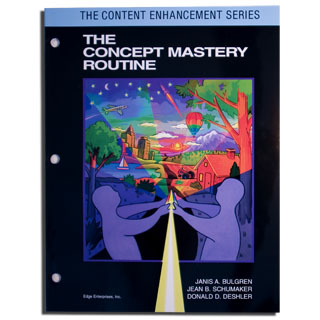
Publication Info: Edge Enterprises, 1993
Concept Mastery Resources:
VIDEO
- 2013 Content Enhancement as Essay Writing Support Video
- 2006 SIM Conference: CDs for Strategic Tutoring, The Concept Routines and Question Exploration Video
- Preconference 2010: Enhancing CERS: Guidebooks on Integrating CE Routines in Core and Elective Classes Video
- Concept Mastery Workshop Video - Gwen Berry 2000 (01:48:03)
- Video: Sean Strickland presents a math Concept Mastery example
- Teaching with the Concept Mastery Routine (Video) (00:18:59)
- Content Enhancement Supplements (02:04:24)\
- Concept Mastery: Concept Diagram - Sue Woodruff (05:13)
- Concept Mastery: Classify Characteristics (4:58)
- Concept Mastery: Tom Ellis, Astronomy Teacher, Muskegon, MI (00:03:49)
- Concept Mastery: Explore Concept Examples (00:06:53)
- Concept Mastery: Stacy Blevins, Drama Teacher, Riverbank, CA (00:03:15)
- SIM and Common Core: Timeline leads to Lifeline for a State (1:13:06)
- 2013: CE and the Common COre (1:50:00) Concept Mastery tools developed.
- Joe Fisher demonstrates using Concept Mastery to teach about a Rhombus (00:16:53)
PPTs
- Concept Mastery Routine presentation (ppt) 2021
- Concept Mastery Routine blank devices
- Concept Mastery presentation deck, Kathy Boyle Gast
MORE
- Access Florida SPDG LiveBinder Assets (Key: CE CM)
- Access Content Enhancement Routine Checklists
- Concept Mastery Google Slide to Copy: https://docs.google.com/presentation/d/1t7iApeXkKvA-DIvulMzWDwpf0eZja8CB/copy#slide=id.p1
- Self-Guided Professional Development with the CM Multi Media Program, Guidebook and Coaching
- Description of the Concept Mastery Routine from the SIM website
- Fish
- Ladder
- PD Packet
- Sorting Exercise
- Concept Master Syllabus from Florida
- Concept Mastery student examples
Stratenotes and Strategram
- Strategram Vol. 20, No. 4, Concept Mastery e-Learning Program
- Stratenotes Vol. 2, No. 5, Page by Page Jaunt Through the Lesson Organizer and Concept Mastery Guidebooks
- Strategram Vol. 4, No. 4: Planning for concept instruction
Micro-credentials
Assets from FLORIDA SPDG Livebinders:
Teacher can access Florida Live Binder assets. Share this link and password:
https://www.livebinders.com/play/play_shared_binder/780885?play_view=play Password CE CM
- Cue Do Review
-
The overall instructional process that guides use of the CE device with the Routine’s Linking Steps. This instructional process involves:
Cue: teacher announces the CE routine and explains its use, how it will help students and expectations for student participation
Do: teacher and class collaboratively construct the device using the Linking Steps that “connect” the content to the needs and goals of students
Review: Information presented in the device is reviewed and confirmed, use of the device is reviewed and confirmed, use of the device as a learning and study tool is modeled
See it in action:
Explore Concept Examples: https://vimeo.com/171624576/030e1474bbStrategies when students struggle: https://vimeo.com/simnetwork/review/171624575/a2b929a106Classify Characteristics: https://vimeo.com/171624574/83dc6ac9b9Concept Diagram: https://vimeo.com/simnetwork/review/87102087/474c2a962eDemonstration by Sue Woodruff: https://vimeo.com/simnetwork/review/87102084/6035063bd9 - The Routine
-
Teaching ppt (pdf)
- Device Templates
- Device Checklist
- Examples
- Implementation Checklist
- Concepts Examples by Subject area
Research
- Concept Mastery Routine Research slide Bulgren, J.A., Schumaker, J.B., & Deshler, D.D. (1988). Effectiveness of a concept teaching routine in enhancing the performance of LD students in secondary-level mainstream classes. Learning Disability Quarterly, 11(1), 3-17. Multiple-baseline studies with a wide array of variables are used to measure teacher effectiveness with Concept Diagrams and the Concept Teaching Routine in heterogeneous regular education classrooms and their effect on students (with and without LD) using several classroom performance indicators. Lenz, B.K., Bulgren, J.A., & Hudson, P. (1990). Content enhancement: A model for promoting the acquisition of content by individuals with learning disabilities. in T.E. Scruggs & B.L.Y Wong (Eds.), Intervention research in learning disabilities (pp. 122-165). New York: Springer-Verlag. This book chapter discusses information processing and pedagogy for students with learning disabilities, including suggestions for teacher planning and teaching routines such as the Chapter Survey Routine, Concept Teaching Routine, and ssignment Completion Routine. Shaw, J.M., Thomas, C., Hoffman, A., & Bulgren, J. (1995). Using concept diagrams to promote understanding in geometry. Teaching Children Mathematics, 2(3), 184-189. An example of using the Concept Mastery Routine for teaching geometric properties and relationships in mathematics to middle- and upper-grades students is provided.
Schumaker, J. B., & Fisher, J. B. (in press). 35 years on the road from research to practice: A review of studies on four Content Enhancement Routines for inclusive subject-area classes, Part I. Learning Disabilities Research & Practice. Advance online publication. 1 -16. https://doi.org/10.1111/ldrp.12258
